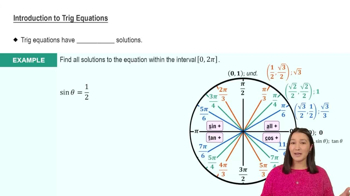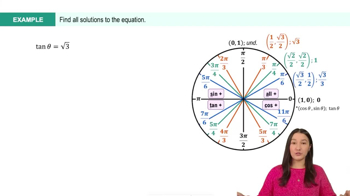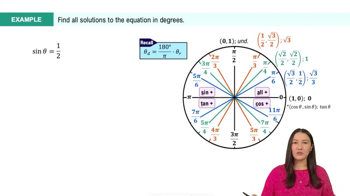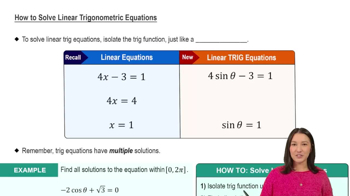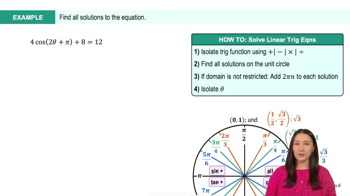Table of contents
- 0. Review of College Algebra4h 43m
- 1. Measuring Angles39m
- 2. Trigonometric Functions on Right Triangles2h 5m
- 3. Unit Circle1h 19m
- 4. Graphing Trigonometric Functions1h 19m
- 5. Inverse Trigonometric Functions and Basic Trigonometric Equations1h 41m
- 6. Trigonometric Identities and More Equations2h 34m
- 7. Non-Right Triangles1h 38m
- 8. Vectors2h 25m
- 9. Polar Equations2h 5m
- 10. Parametric Equations1h 6m
- 11. Graphing Complex Numbers1h 7m
5. Inverse Trigonometric Functions and Basic Trigonometric Equations
Linear Trigonometric Equations
Problem 11
Textbook Question
In Exercises 11–24, find all solutions of each equation. __ √ 3 sin x = ------- 2
 Verified step by step guidance
Verified step by step guidance1
Recognize that the equation \( \sin x = \frac{\sqrt{3}}{2} \) is a standard trigonometric equation.
Recall that \( \sin x = \frac{\sqrt{3}}{2} \) corresponds to specific angles on the unit circle, namely \( x = \frac{\pi}{3} \) and \( x = \frac{2\pi}{3} \) in the interval \([0, 2\pi)\).
Since the sine function is periodic with a period of \(2\pi\), the general solutions can be expressed as \( x = \frac{\pi}{3} + 2k\pi \) and \( x = \frac{2\pi}{3} + 2k\pi \), where \( k \) is any integer.
Consider the periodic nature of the sine function to ensure all solutions are captured by adding integer multiples of the period \(2\pi\).
Verify the solutions by substituting back into the original equation to ensure they satisfy \( \sin x = \frac{\sqrt{3}}{2} \).
Recommended similar problem, with video answer:
 Verified Solution
Verified SolutionThis video solution was recommended by our tutors as helpful for the problem above
Video duration:
6mPlay a video:
Was this helpful?
Key Concepts
Here are the essential concepts you must grasp in order to answer the question correctly.
Trigonometric Functions
Trigonometric functions, such as sine, cosine, and tangent, relate angles to the ratios of sides in right triangles. The sine function, specifically, represents the ratio of the length of the opposite side to the hypotenuse. Understanding these functions is crucial for solving equations involving angles and their corresponding values.
Recommended video:

Introduction to Trigonometric Functions
Inverse Trigonometric Functions
Inverse trigonometric functions, such as arcsin, arccos, and arctan, are used to find angles when given a ratio. For example, if sin(x) = a, then x can be found using x = arcsin(a). This concept is essential for determining the angle solutions in trigonometric equations.
Recommended video:

Introduction to Inverse Trig Functions
Periodic Nature of Trigonometric Functions
Trigonometric functions are periodic, meaning they repeat their values in regular intervals. For sine, the period is 2π, indicating that sin(x) = sin(x + 2πn) for any integer n. This property is important when finding all solutions to trigonometric equations, as it allows for the identification of multiple angle solutions within specified ranges.
Recommended video:

Period of Sine and Cosine Functions

 4:25m
4:25mWatch next
Master Introduction to Trig Equations with a bite sized video explanation from Callie Rethman
Start learning
